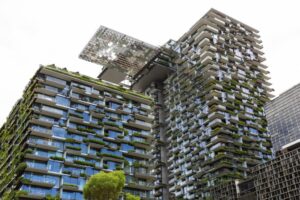How to Beat the Heat With Smart Building Designs
One of the hottest summers on record is underscoring a new challenge for building owners and managers. Nationwide temperature spikes are placing new pressure on energy consumption and operating costs. But aid temperatures that often top triple digits, developers, operators and managers have many ways to beat the heat.
Experts emphasize that effective design doesn’t necessarily require novel technology; it’s all about thoughtful planning and implementation. “During the early development stage, developers should integrate climate and water risk assessments into site selection. This allows them to identify opportunities to improve the sustainability and resilience of the asset and preserve strong market value,” noted Joe Rozza, chief sustainability officer at Ryan Cos.
Thermal enclosures, passive systems, and orientation and shading are elements of design and operation that offer the greatest opportunity for efficiency. The building’s thermal enclosure plays a huge role in controlling temperature advised Daniel Piselli, principal & director of sustainability at FXCollaborative. Best results require a combination of insulation, air sealing, and the appropriate proportion of windows on the wall area.
For JEA, an electric, water and sewer utility in Jacksonville, Fla., Ryan Cos. developed a new headquarters which draws on solar panels to meet part of the building’s energy needs. Image courtesy of Ryan Cos.
Gains from glass and glazing
The best-performing windows are much worse thermally than the worst-performing walls, said Brenden McEneaney, senior vice president for sustainability at JLL. For office and other non-residential properties, glass that accounts for at least 30 percent of the building’s wall surfaces is necessary to provide adequate daylight for lighting energy reduction and biophilic connection to the outdoors. That can be a backup when extreme heat results in power outages and daylight is crucial to maintaining operations.
When buildings’ orientations are restricted, it’s preferable to locate glass where solar heat gain can be controlled—particularly in the north and south facades—and reduce the volume of glass on the east façade and especially the west facade, where heat gain is more difficult to control, and the late-day sun makes an already hot building even hotter. Triple glazing, vacuum-insulated glazing, and high-performance window frames can help achieve a high-quality thermal envelope with more glass.
Anthony Brower, global climate action & sustainability leader at Gensler, recommends opting for higher insulation values and more thermally resistant glazing than the code minimum recommends and paying extra attention to air sealing to minimize infiltration.
Finding an alternative to an all-glass system lessens the sunlight burden and is another key to also reduces heat gain, “Opaque surfaces reduce heat gain and glare and can provide a more comfortable– thermally and visually–interior environment,” said Alan Barker, principal at Lamar Johnson Collaborative. One caveat: He adds that the strategy is inherently compatible with multifamily design but has to be more thoughtfully implemented for a typical corporate office building.
Existing buildings are a bigger challenge for increasing heat extremes because most have outdated systems that are difficult and expensive to retrofit—particularly while tenants are in the building.
—Brennen McEneaney, senior vice president for sustainability, JLL
Cutting consumption with chilled beams
Existing buildings “are a bigger challenge for increasing heat extremes because most have outdated systems that are difficult and expensive to retrofit – particularly while tenants are in the building,” McEneaney said. Retrofitting the building envelope can be expensive, but high-performance new window products are available to reduce heat infiltration and the energy demand on building systems, he noted.
One Congress, Carr Properties’ 43-story Boston office tower, employs a highly efficient chilled beam MEP system. Its use of water for cooling is much more energy efficient than traditional air-based systems. The result is lower energy consumption, reduced HVAC heat generation, and better temperature control, which boosts resilience.
These high-efficiency systems, including a central plant for cooling towers, chillers, and condensing boilers, combined with a 100 percent LED lighting design, help reduce energy consumption and greenhouse gas emissions contribute to nearly 27 percent projected annual reduction in both energy consumption and greenhouse gas emissions, according to Oliver Carr, CEO of Carr Properties.
ERVs use cooled outgoing exhaust air to precondition the warmer air coming in from outside, thus reducing the HVAC system’s energy consumption, as the Air-Conditioning, Heating and Refrigeration Institute notes. When ERVs systems are paired with a building envelope and powered by emergency generators—or tied into solar power and battery systems—they can help keep a building in a safe temperature range for longer while also providing fresh air.
When local ground conditions are right, closed-loop geothermal HVAC systems are an attractive option. They can release heat into the ground without consuming water and are much more efficient than releasing heat to the air during a hot day. These systems also provide reliable, consistent capacity, even during extreme heat.
During the early development stage, developers should integrate climate and water risk assessments into site selection. This allows them to identify opportunities to improve the sustainability and resilience of the asset and preserve strong market value.
—Joe Rozza, chief sustainability officer, Ryan Cos.
Reducing the carbon footprint
Net-zero and Passive House design principles continue to gain traction. Buildings that have attained net- zero status, or which are net-zero ready, can significantly reducing their carbon footprint by connecting to on-site or municipal renewable energy sources.
Other passive strategies include lightweight cladding that does not absorb much heat, Piselli said. For example, a concrete facade gets hot in the sun and stays hot, creating heat load that persists through the night. A lightweight rain screen cools down much faster.
Using materials with a high albedo factor—reflecting a large degree of sunlight—and create shade inside and outside can help mitigate direct heat, Piselli said. Light-colored roofs, roofs shaded by solar panels, and green roofs can reduce the building’s heat load and urban heat island effects around the site.
And Sadaf Jafari, director of sustainable design at SGA, noted that integrating photovoltaic receptacles into window glazing facilitates on-site renewable energy production, harnessing solar power to support building operations.
Located east of Oakland in San Ramon, Calif., the San Ramon Valley Conference Center uses durable, colorful shade structures that deflect heat and create “outdoor room” options for tenants and visitors. Image courtesy of Gates + Associates
Made in the shade
Ideas for battling the effects of extreme heat extend beyond building structure and systems. Landscape designs can reduce heat in buildings and provide adjacent spaces, such as outdoor rooms for relaxation, small meetings and lunch breaks, according to Casey Case, president of the Gates + Associates landscape architecture firm. For new-construction properties, he advises, make use of existing trees on the site and situate the structure to use natural shade.
Similarly, shade structures can provide partial sun protection for buildings and shade high-traffic areas, such as a main entrance or relaxation garden. These structures are often high-performance fabric, metal fins and awnings, and may even double as public art.
Vertical green screens of climbing plants can shade the sunniest side of a building. Green roofs have become increasingly popular for reducing a building’s heat gain.
And don’t forget a timeless technique that provides benefits: Installing operable windows that supply natural ventilation, Keith Heinemann, senior vice president & studio director for architecture, design solutions, project and development services at JLL.
Read the August 2024 issue of CPE.
The post How to Beat the Heat With Smart Building Designs appeared first on Commercial Property Executive.




